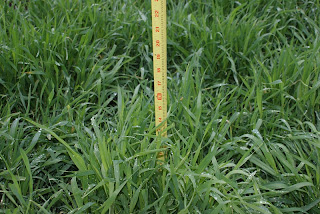Back when I first started this blog. What two months ago? I touched a bit on covercrops and how they benefit your soil in a lot of important ways. But that doesn't really give it due coverage because this is an excellent way to put a huge amount of biomass back into your soil.
At nearly 16" high in only 8 weeks (really only 6 if you consider the less than ideal growing conditions this small plot has gone through), there's no question that the shear volume of organic matter you can grow is worth the time and effort. In another week we'll be tilling this into the soil, supplying food for bacteria, fungi, insects such as worms and really the whole system. There are alternatives of course, but unless you're going to douse your fields with fertilizers you're going to need a strong soil food web. This type of cycle is essential in natural ecological systems, and strong chemical free gardens.
Not only has this plot provided enormous quantities of converted solar energy for the soil, it's also given my chickens nutrients and energy as a food source and a nice protected spot for dust bathing. We'll be working a cover crop into our tight rotations whenever we can, and you should too.





When do you plant your cover? Can you do this in the fall w/ a winter rye and then till it in the spring?
ReplyDeleteI plan on doing that this next year, too late now. I'm tilling and adding organic compost into the soil, but that is expensive to say the least (I have a fairly large garden).
Damien, you are truly great at this, I have much to learn from you. Thanks for the effort
The nice thing about this rye is you can grow it all year. Obviously it won't do as well in the winter, but it will survive. I started this in late February. With a couple warm days I managed to get the seeds sprouted under plastic. Not more than a week after the chutes were poking up did they get snowed on, with no ill effects. You really need about 3 months of total growing time, and depending on what you plant you can squeeze it in before your vegetable crops. I could have easily started this in my tomato bins this year. It's best to divide your garden space into areas that will get a cover crop, a cold weather crop, or a warm weather crop. Keep something growing year round with about 2-4 weeks in between plantings (to allow the decomposition to take place) and it'll help with nutrient absorption as well as disease, weed and pest suppression. There are a ton of other cover crop options. Some with shorter growing ranges such as buckwheat, which will be ready to till into the soil in about 30 days.
ReplyDelete